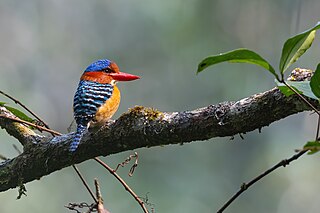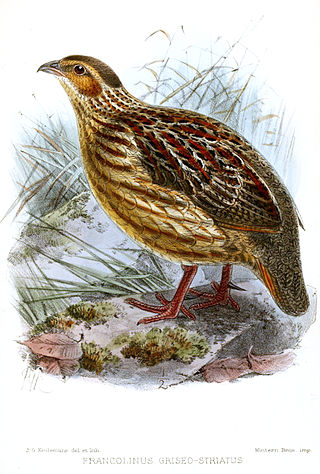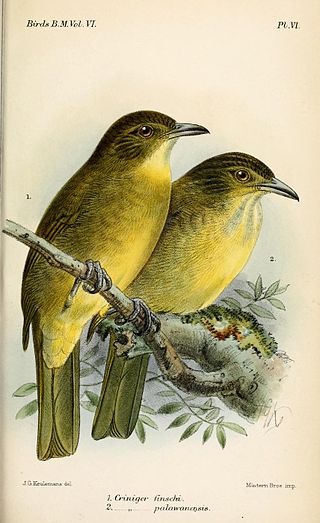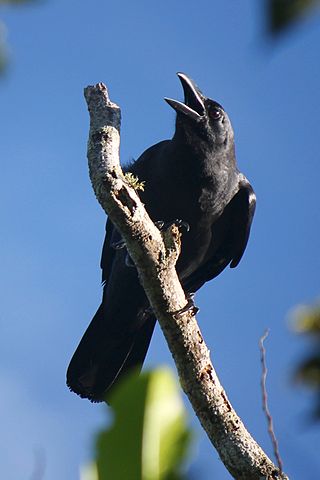
The zebra dove, also known as the barred ground dove, or barred dove, is a species of bird of the dove family, Columbidae, native to Southeast Asia. They are small birds with a long tail, predominantly brownish-grey in colour with black-and-white barring. The species is known for its pleasant, soft, staccato cooing calls.

The red-throated parrotfinch is a species of estrildid finch found in New Caledonia. It has an estimated global extent of occurrence of 20,000 to 50,000 km2.

The banded kingfisher is a tree kingfisher found in lowland tropical forests of southeast Asia. It is the only member of the genus Lacedo. Male and female adults are very different in plumage. The male has a bright blue crown with black and blue banding on the back. The female has rufous and black banding on the head and upperparts.

The grey-striped spurfowl is a species of bird in the family Phasianidae. It is found only in Angola.

Finsch's bulbul is a species of songbird in the bulbul family, Pycnonotidae. It is found on the Malay Peninsula, Sumatra, and Borneo. Its natural habitat is subtropical or tropical moist lowland forests. It is threatened by habitat loss.

The yellow-gorgeted greenbul, formerly known as the yellow-throated leaflove, is a species of passerine bird in the bulbul family Pycnonotidae. It is found in West Africa. Its natural habitats are subtropical or tropical dry forests, moist savanna, and subtropical or tropical moist shrubland.

The straw-headed bulbul is a species of songbird in the bulbul family, Pycnonotidae. It is found from the Malay Peninsula to Borneo. Its natural habitats are subtropical or tropical moist lowland forest, subtropical or tropical mangrove forest, subtropical or tropical moist shrubland, arable land, plantations, and rural gardens. It is threatened by habitat loss and poaching.

The spice imperial pigeon is a species of bird in the family Columbidae. It is endemic to Indonesia, where it occurs in the eastern Moluccas and the Raja Ampat Islands. Its natural habitats are subtropical or tropical moist lowland forests and subtropical or tropical mangrove forests. It eats, and is an important disperser of seeds for, fleshy fruits.

The Oriental cuckooshrike is a species of bird in the family Campephagidae. It is widely distributed from the Himalayas through Southeast Asia to east China and Taiwan. It is also found on the islands of Java and Bali in Indonesia. Its natural habitat is subtropical or tropical moist lowland forest. The range of this species was formerly restricted to Java and Bali and had the English name "Javan cuckooshrike".

The Sunda crow, formerly known as the slender-billed crow, is a passerine bird of the family Corvidae, in the genus Corvus. It is found from Malaysia to Borneo. The violet crow has been shown to be distinct genetically and separated as Corvus violaceus. The small crow has been split as Corvus samarensis and the Palawan crow has also been split as Corvus pusillus.

The buff-breasted mountain tanager is a species of Neotropical bird in the tanager family Thraupidae.

The dark-throated oriole is a species of bird in the family Oriolidae.

The Guianan red cotinga is a species of bird in the family Cotingidae, the cotingas. It is one of two species in the genus Phoenicircus.

The large woodshrike is found in south-eastern Asia, Sumatra, Java, and Borneo. Its natural habitats are temperate forest, subtropical or tropical moist lowland forest, subtropical or tropical mangrove forest, and subtropical or tropical moist montane forest.

The heart-spotted woodpecker is a species of bird in the woodpecker family. It has a contrasting black and white plumage, a distinctively stubby body and a large wedge-shaped head making it easy to identify while its frequent calling make it easy to detect as it forage for invertebrates under the bark of the slender outer branches of trees. They move about in pairs or small groups and are often found in mixed-species foraging flocks. They have a wide distribution across Asia with populations in the forests of southwestern and central India which are slightly separated from their ranges in the Himalayas and Southeast Asia.

Hemicircus is a genus of birds in the woodpecker family Picidae. Members of the genus are found in India and Southeast Asia.

The grey-and-buff woodpecker is a species of bird in the family Picidae. It is found in Brunei, Indonesia, Malaysia, southern Myanmar, and southern Thailand, but has become regionally extinct in Singapore. Its natural habitats are lowland and montane tropical or subtropical moist broadleaf forests.

Meiglyptes is a genus of Southeast Asian birds in the woodpecker family Picidae.

The buff-rumped woodpecker is a species of bird in the family Picidae. It is found in southern Myanmar, Thailand, Malaya, Sumatra and Borneo. Its natural habitats are subtropical or tropical dry forests and subtropical or tropical moist lowland forests. It was previously considered conspecific with the zebra woodpecker.

The necklaced woodpecker is a species of bird in the family Picidae. It is found in Bangladesh, China, Laos, Myanmar, Thailand, and Vietnam. Its natural habitats are subtropical or tropical moist lowland forests and subtropical or tropical moist montane forests.




















